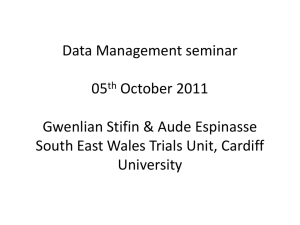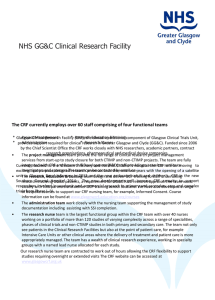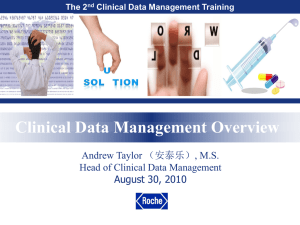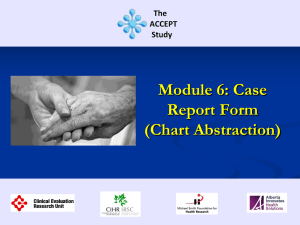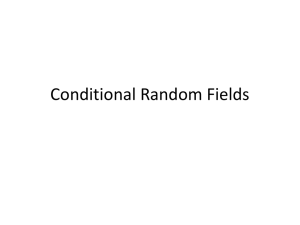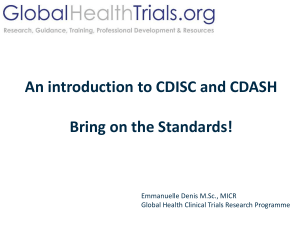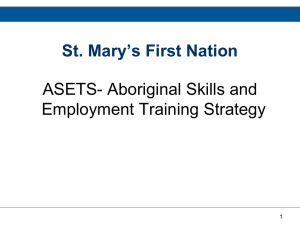CRF Completion Guidelines
advertisement
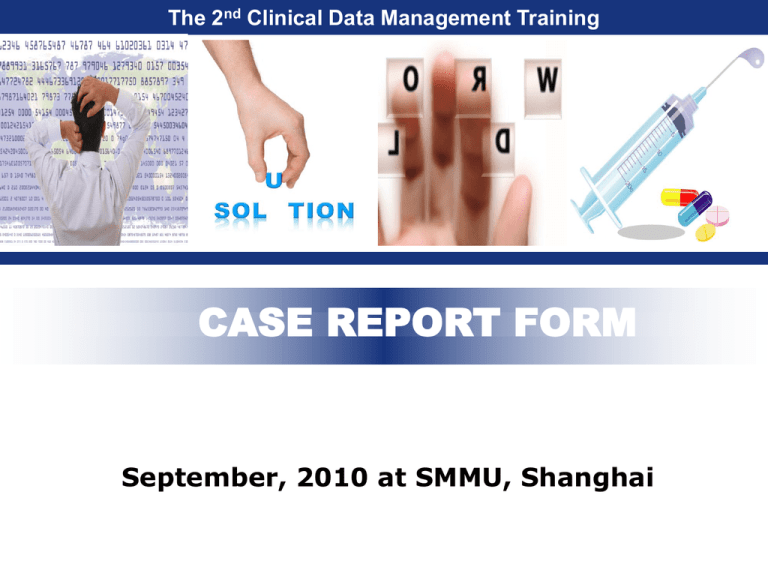
The 2nd Clinical Data Management Training CASE REPORT FORM September, 2010 at SMMU, Shanghai What is the definition of CRF? A printed, optical or electronic document designed to record all of the protocol required information to be reported to the Sponsor on each trial subject. ---ICH/GCP CRF If we take care in the beginning, the end will take care of itself !! 2 From CDASH There is arguably no more important document than the instrument that is used to acquire the data from the clinical trial, with the exception of the protocol, which specifies the conduct of that trial. The quality of the data collected relies first and foremost on the quality of that instrument. No matter how much time and effort go into conducting the trial, if the correct data points were not collected, a meaningful analysis may not be possible. It follows, therefore, that the design, development and quality assurance of such an instrument must be given the utmost attention.” 3 Purpose of the CRF Capturing all protocol-required information. Facilitates data collection and entry Benefits data management Benefits statistical analysis Simplifies database design and data validation processes as well as manipulation of data during statistical analysis. 4 Outlines 1 CRF Development Process 2 CRF Design 3 CRF Completion Guidelines 4 Take Home Message 5 CRF Development Workflow 6 What do we know from protocol? Study objectives – safety and efficacy Efficacy parameters Safety parameters Time and Event schedule Study working flow Detailed procedures 7 Some information out of protocol What data need to be collected if a subject dose not meet entry criteria (SF) or complete the study? (ET) How is dosing/compliance being measured? What population-specific data are needed? Lab (central vs local) Unscheduled procedures? 8 General Modules IC/DEMO INC/EXC (cross check? option of “NA”) Med Hx (specific Hx, general Hx) PE (body system) Vital Signs, 12-lead ECG, Chest X-ray, Holter, etc (data collected depends on the study) ConMed (time period) AE (definition, data collected, reported timeframe, follow-up period) Protocol deviations Comment Log Study drug administrationi/Study drug accountability log 9 Forms Data Type Examples of Data CRF layouts Dataset Structure in the database Non-Time Dependent Time Dependent Demo MH IC/EC … PE Lab … Fields are designed to capture data as a whole … One observation per subject VS … AE ConMed … One set of fields is structurally aligned and repeated about 4 to 10 times per page to allow Recording multiple sets of observations One observation per scheduled time point and subject 10 Cumulative Log Multiple observations per subject Categories of Questions Open question When, What, Where, Who, How Close question Yes/No 11 How to Ask Questions? When Date or time? Duplicate recording Protocol defined vs Actual Date/Time Sample collection, Sample testing Yes/No Double negative • E.g. • E.g. Wasn’t the patient fasting before blood withdrawl? Several options • Is the parameter A greater than 10 and the parameter B greater than 5? Others Avoiding using words that have more than one meaning Using single word to replace unnecessary phrases Avoid passive voice Break down Leading questions Notes and reminder 12 Answers Date/Time (format) Number (digits) Text (space) Units (per-printed or not) Options/Discrete Value Groups 13 Answers (cont.) Response order Yes/no/unknown Most likely options occur early Grading performance – from good to worse Numeric answers Tick box order Recording codes Exclusive options Combination questions Other specify None of the above 14 Analogue scales Provide clear instructions for marking the line Ensure the line is exactly 10 cm in length on return form the printers Copyright 15 16 CRF Design (general) Study information (sponsor, protocol number, phrase, title) Subject information (site num, patient num, patient initials) Informative footer and header 17 CRF Design (specific) Diary Card ( medical synonyms; domestic time; medication; structure) Specific data modules depends on individual Translations Translations of CRFs into other languages should be a parallel process following the same set of steps with separate reviews and approvals by the appropriate experts. 18 Precision – improve data quality Key dates and times Necessary Data Only Calculated data or derived data Objective measurements are the data of choice With multivariable information – focus on the factor of interest is present absent Standard ‘definitions’ exist when asking if a result is ‘normal’ or ‘abnormal’ 19 Exercises (1)- Local Lab Result Neutrophils I____I Lymphocytes I____I Result Neutrophils (%) Lymphocytes (%) I____I I____I 20 Unit If different I____I I____I Exercises (2)- PE 21 Exercises (2)- PE 22 Why employ standards Reduces production time for CRF design and reduces review and approval time. Reduces site re-training and queries and improves compliance and data quality at first collection Facilitates efficient monitoring, reducing queries Improves the speed and quality of data entry due to familiarity with standards and reduces the training burden in-house Enables easy reuse and integration of data across studies and facilitates “data mining” and the production of integrated summaries Reduces the need for new clinical and statistical programming with each new study 23 CRF Review CRF captures all of the data needed for analysis. Data are collected in a manner which should also be easy for the site to complete. 24 Key points for different functions CRF designer: review the protocol to ensure that it is possible to collect the proposed data. Statisticians: review the CRF against their planned analyses to make sure all required data will be collected in an appropriate form for those analyses. Clinical Operations staff: make sure the questions are unambiguous and that it is possible to collect the data being requested. Programmers: ensure that the manner in which the data are collected on the CRF will not adversely affect the programming function. Scientific experts: provide input on the efficacy and/or safety data collection fields, and educate the Clinical Data Management (CDM) staff on the type and methods of collecting those data. Regulatory: review the CRF for compliance with all applicable regulations. Data Entry is an important “user” of the CRF and their perspective should be included in the review as well. Pharmacovigilance should review to ensure appropriate data capture and process to support expedited reporting. 25 CRF Completion Guidelines Provide a set of instructions for the site to use during the process of filling out the Case Report Form for the study The instructions should be clear, concise, definite, consistent and correct. Significant reduce data entry errors (for EDC studies), query rate and eventually increase the accuracy and integrity of clinical data 26 CRF Completion Guidelines (cont.) CRF questions should be as self-explanatory as possible, thereby reducing the need for separate instructions. When instructions are needed, prompts and short instructions may be placed on the CRF page. More detailed instructions may be presented in a CRF completion guideline for paper CRFs, or in a context-sensitive help file for electronic CRFs (eCRFs). Instructions should be standardized along with the CRF as much as possible. This promotes standardization in that all sites will use the same conventions for completing the fields. 27 Q and A Should free text be an option for a response to a specific question? Should data be pre-populated in the CRF? Should location of measurement and position of subject (e.g., oral temperature, blood pressure from right arm, etc.) be collected for each assessment? Should sites be given guidance on how to record verbatim terms for adverse events, concomitant medications or medical history in the CRF? Should dosage to be recorded one by one? 28 Take Home Messages Keep questions, prompts and instructions clear and concise. Design the CRF to follow the data flow from the perspective of the person completing it. Avoid referential and redundant data points within the CRF whenever possible. Design the CRF with the primary safety and efficacy endpoints in mind as the main goal of data collection. Keep the layout (Font, table, etc.) consistent 29 The 2nd Clinical Data Management Training Click to edit company slogan .

